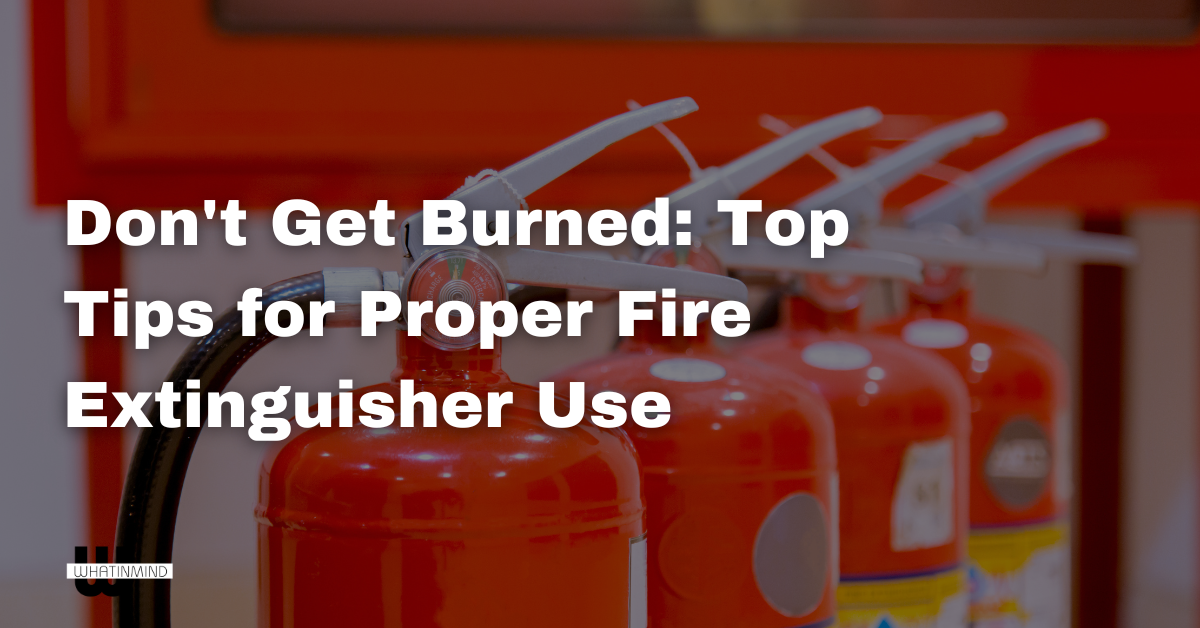Don’t Get Burned: Top Tips for Proper Fire Extinguisher Use
In the event of a fire, having a fire extinguisher on hand can make all the difference between a small, manageable incident and a catastrophic disaster. However, simply having a fire extinguisher isn’t enough; knowing how to properly use it is essential for effective firefighting and personal safety.
In this guide, we’ll explore top tips for the proper use of fire extinguishers, empowering you with the knowledge you need to stay safe and protect your property in case of a fire emergency.
Table of Contents
Choose the Right Type of Fire Extinguisher:
Not all fires are the same, and different types of fire extinguishers are designed to tackle specific types of fires. The most common types of fire extinguishers include:
- Class A: For fires involving ordinary combustible materials like wood, paper, and cloth.
- Class B: Suitable for flammable liquids such as gasoline, oil, and grease.
- Class C: Designed for electrical fires involving live electrical equipment.
- Class D: Intended for fires involving combustible metals like magnesium and sodium.
- Class K: Specifically designed for fires involving cooking oils and fats in commercial kitchens.
It’s crucial to select the appropriate type of fire extinguisher for the specific hazards present in your environment.
Know How to Operate the Fire Extinguisher:
Familiarize yourself with the PASS technique:
- Pull the pin: This unlocks the operating lever and allows you to discharge the extinguisher.
- Aim low: Point the extinguisher nozzle or hose at the base of the fire to smother the flames.
- Squeeze the lever: This releases the extinguishing agent.
- Sweep from side to side: Move the extinguisher back and forth to cover the entire fire area until the flames are fully extinguished.
Practicing the PASS technique beforehand can help you act quickly and confidently during a fire emergency.
Maintain Your Fire Extinguishers:
Regular maintenance is crucial to ensure that your fire extinguishers are in good working condition when you need them most. Perform the following checks periodically:
- Check the pressure gauge to ensure it’s in the proper operating range.
- Inspect the extinguisher for signs of damage, corrosion, or leakage.
- Make sure the nozzle or hose is unobstructed and free of debris.
- Verify that the safety pin is intact and the tamper seal is unbroken.
If you notice any issues during your inspection, replace or recharge the extinguisher immediately.
Position Fire Extinguishers Strategically:
Position fire extinguishers in convenient locations within your home or workplace, particularly in areas prone to fire hazards like kitchens, garages, and workshops. Ensure that the extinguishers are securely mounted on walls or stored in cabinets, making them easily accessible for emergency use. Additionally, consider incorporating fire extinguisher decoration elements to make the extinguishers more visually appealing while still maintaining their accessibility and functionality.
Stay Safe and Evacuate if Necessary:
Before attempting to use a fire extinguisher, assess the situation and determine if it’s safe to do so. If the fire is spreading rapidly, the smoke is thick and black, or if you’re unsure whether you can extinguish the fire, evacuate immediately and call the fire department.
Train Yourself and Others:
Provide training to yourself, your family members, and your employees on how to properly use fire extinguishers. Conduct regular fire drills to practice evacuation procedures and reinforce safety protocols. Knowledge and preparedness are key to minimizing the risk of injury and property damage during a fire emergency.
Also Read: Choice Home Warranty George Foreman: Benefits and Coverage
In Conclusion
Fire extinguishers are valuable tools for fire suppression, but their effectiveness depends on proper use and maintenance. By choosing the right type of extinguisher, knowing how to operate it, and following safety protocols, you can enhance your ability to respond effectively to a fire emergency and protect yourself and others from harm. Don’t wait until it’s too late—take proactive steps to ensure you’re prepared to handle a fire safely and confidently.






